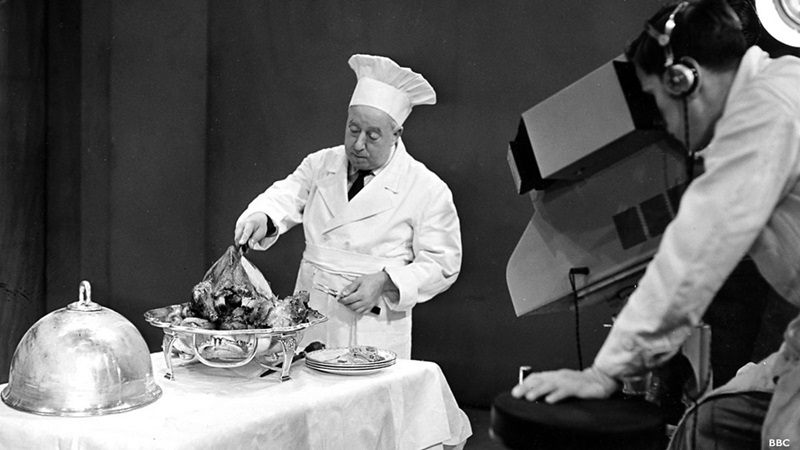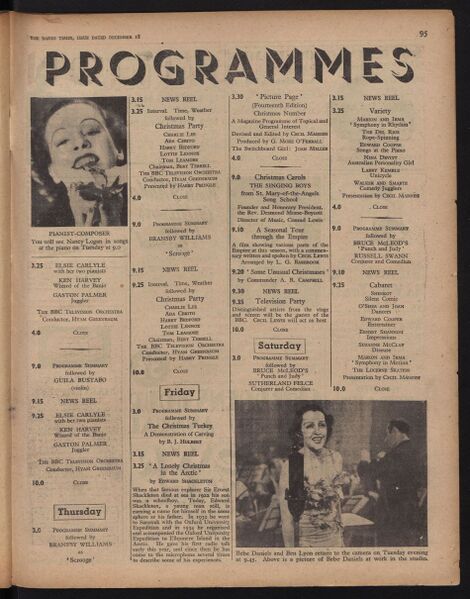The Christmas Turkey: A Demonstration of Carving (lost televised Christmas dinner tutorial; 1936)
Christmas of 1936 marked the first festive season since the BBC publicly launched its high-definition television service. Therefore, it proved fitting for the corporation to air a series of live Christmas programmes. The first to be aired on Christmas Day was titled The Christmas Turkey: A Demonstration of Carving, which featured B. J. Hulbert providing a 15-minute tutorial on appropriately carving a turkey.
Background
On 2nd November 1936, the opening of the BBC Television Service occurred.[1][2] While pre-Second World War programming was limited to only a few hours in the afternoon and evening for financial and health reasons, it still nevertheless catered to a dedicated audience primarily within London.[3][4] Not long following the inaugural day of high-definition broadcasting, the Christmas season approached.[5] To that end, the BBC decided to air a series of programmes to celebrate the occasion.[6][7][5] Naturally, these early broadcasts were humble, in the face of budget and time restrictions and the fact only around 400 households could afford expensive television sets back then.[7][5][6][3] Thus, when the service launched at 3 pm on Christmas Day, viewers watched B. J. Hulbert's demonstration on carving a turkey.[8][9][10][6]
Alas, there is little information surrounding Hulbert's life and career. Most sources, perhaps understandably, focus on the man's influence on British Christmas television.[6][10] A photo during the 15-minute broadcast showed him in a white chef's uniform as he calmly instructed the viewers on each step of the carving process.[11][5] The tutorial reflected how turkeys became the desired Christmas feast for many British families from the 1920s to 1930s.[12] But as noted by Royal Television Society, airing the tutorial at 3 pm probably made little sense, as it occurred after the lunch period.[7] The broadcast, as well as other festive programmes like A Lonely Christmas in the Arctic by Edward Shackleton,[8][9][5] came and went with little fanfare.[10][6][7] Ultimately, the 1953 Coronation of Queen Elizabeth II was responsible for television's mainstream appeal going forward.[13][10] Nevertheless, The Christmas Turkey: A Demonstration of Carving paved the way for more extravagant BBC Christmas programmes over the years, including outlandish Christmas specials for its regular shows like Doctor Who.[14][7][6][10] Some sources, including Express & Star, even consider it as the first proper Christmas television production beyond just the United Kingdom.[15]
Availability
A large majority of the BBC's early television output aired live, with The Christmas Turkey: A Demonstration of Carving being no exception.[16][17] At this point, the BBC had yet to develop adequate means of directly recording its programming.[17] An amateur cinefilm recording helped partially preserve the Coronation of King George VI while some output that managed to travel to the United States was captured by RCA.[16][4][17] However, it was not until 7th October 1947 that telerecording became possible, with Variety in Sepia becoming the first show to be preserved in this fashion.[18] Thus, The Christmas Turkey is lost forever, along with almost all pre-Second World War BBC television output.[16][17] Nevertheless, a photo of Hulbert carving the turkey, plus a summary by Issue 690 of Radio Times, ensures a pivotal piece of British Christmas television history is permanently documented.[8][9][5]
Gallery
Image
Lost BBC Live Broadcasts
- Cook's Night Out (lost early BBC cooking show; 1937)
- Dish of the Month (lost early BBC cooking show; 1937)
- Foundations of Cookery (lost early BBC cooking show; 1939)
- Marcel Boulestin television shorts (lost early BBC programs; 1937-1939)
References
- ↑ Terra Media detailing the opening of the BBC Television Service. Retrieved 25th Dec '23
- ↑ BBC summarising the unveiling of the "first regular hi-definition television service". Retrieved 25th Dec '23
- ↑ 3.0 3.1 British Film Institute summarising the limited output of pre-Second World War BBC television. Retrieved 25th Dec '23
- ↑ 4.0 4.1 Dusty Old Thing summarising how most early broadcasts were restricted to a 30-mile range, but with one somehow ending up being received in the United States. Retrieved 25th Dec '23
- ↑ 5.0 5.1 5.2 5.3 5.4 5.5 BBC Genome Blog summarising the occasion and providing the sole surviving photograph of the broadcast. Retrieved 25th Dec '23
- ↑ 6.0 6.1 6.2 6.3 6.4 6.5 Saga on the humble programmes the BBC aired in 1936, and how Christmas television in Britain has expanded ever since. Retrieved 25th Dec '23
- ↑ 7.0 7.1 7.2 7.3 7.4 Royal Television Society summarising BBC's 1936 Christmas Day programming and how The Christmas Turkey's air time made sense. Retrieved 25th Dec '23
- ↑ 8.0 8.1 8.2 BBC Genome archive of Radio Times issues detailing the broadcast and other programming on Christmas Day 1936. Retrieved 25th Dec '23
- ↑ 9.0 9.1 9.2 Issue 690 of Radio Times listing the broadcast Retrieved 25th Dec '23
- ↑ 10.0 10.1 10.2 10.3 10.4 Readily noting the impact of the programme on future British Christmas television. Retrieved 25th Dec '23
- ↑ For the Housewife? From ‘The Singing Cook’ to ‘Common-Sense Cookery’ describing the lone photograph of Hulbert in action (p.g. 3). Retrieved 25th Dec '23
- ↑ English Heritage summarising how turkeys became the centrepiece of many British Christmases throughout the 1920s and 1930s. Retrieved 25th Dec '23
- ↑ Science Museum detailing how the Coronation of Queen Elizabeth II helped British television become mainstream. Retrieved 25th Dec '23
- ↑ Bleeding Cool summarising Doctor Who's Christmas specials. Retrieved 25th Dec '23
- ↑ Express and Star considering the programme to be the first Christmas Day broadcast worldwide. Retrieved 25th Dec '23
- ↑ 16.0 16.1 16.2 The 405 Alive FAQ detailing how most pre-Second World War BBC output is forever lost, with only rare exceptions. Retrieved 25th Dec '23
- ↑ 17.0 17.1 17.2 17.3 Web Archive article discussing how most early television is missing due to the lack of directly recording television. Retrieved 25th Dec '23
- ↑ Science and Media Museum summarising the recording of Variety in Sepia. Retrieved 25th Dec '23

